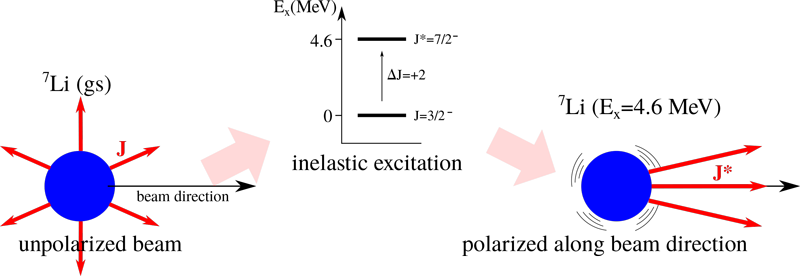A Novel and Universal Polarization Phenomenon
Contributed by Gregory Potel
Atomic nuclei, in their ground and excited states, can rotate with some given angular momentum (spin) around any axis (whenever the spin is different from zero). When the rotation axis has a definite direction, instead of being randomly oriented, the nucleus is said to be "polarized" along that specific direction. Experiments with polarized beams are very useful to shed light on how nuclei rotate, by measuring the magnetic moments associated to the rotating states. More specifically, one can obtain information about the number of nucleons participating in the rotation, thus providing valuable insight on the interplay between collective and single-nucleon aspects of nuclear structure. Unfortunately, polarized beams are usually hard to produce, particularly in excited states.
However, a group of researchers were able to obtain a highly polarized excited lithium-7 beam in a recent experiment. In this experiment, the lithium-7 beam impinged on a carbon-12 target, and was inelastically promoted to an excited state with two more units of internal orbital angular momentum. By measuring the angular correlations of the fragments of the decay of the lithium-7, they were able to determine that the excited state was highly polarized in the direction of the beam. Gregory Potel, an FRIB Theory Fellow at NSCL, contributed to the theoretical explanation for this phenomenon realizing that this kind of large longitudinal polarization, although so far unappreciated, should be a very general effect, present whenever there is a transfer of angular momentum to the internal motion of the beam for beam energies above a threshold. This polarization effect can actually be explained with simple arguments of energy and momentum conservation, giving more confidence on its universality. The conspicuousness of this phenomenon, along with the large alignments obtained, open exciting new possibilities for performing experiments with polarized beams.




